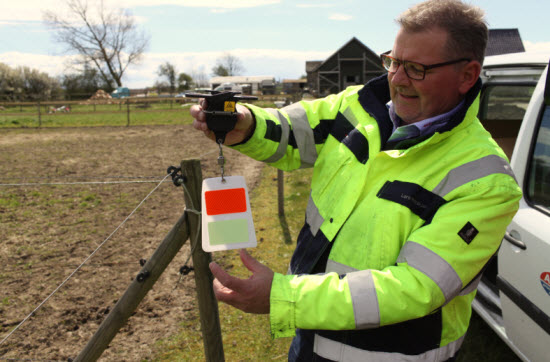With a drone, Energinet has set off the first of a total of approx. 150 rotating reflectors on a nearly 1-kilometer high-voltage stretch off Dybsø Fjord in South Zealand.
In January and February, a number of swans flew into Energinet's high-voltage power lines that line the fjord and fell dead to the ground or were badly injured and had to be euthanized. In foggy or rainy weather, visibility is poor, and the swans can therefore not see the wires when they fly from the fields on land to the fjord – or the other way.
Following good advice from the Danish Ornithological Association, we have chosen a type of marking that can move and rotate and which at the same time has both a UV reflector and is fluorescent, so that the swans have the greatest chance of discovering the wires and flying over, says Jacob Devantier Larsen, acting head of department in Energinet's Assets Engineering department, who has worked to find a solution.
One of the first reflectors to be placed on cables at Dybsø Fjord.
The reflectors are set up at ten meter intervals on the upper "ground wire", and on two of the three phase wires that hang below the ground wire - the upper and the lower one - the reflectors are set up at 20 meter intervals.
WILL THE MAST HOLD UP?
Since the birds began to fly into the wires in large numbers in January and February and fall dead and injured to the ground, Energinet has been working to find the best possible marking method, as well as calculating whether the masts and wires can withstand the extra weight. The individual reflectors do not weigh much, but in stormy weather or in cold weather with ice cover they can have a strong impact on the cables. However, the calculations have shown that the lines can withstand the extra pressure.
The reflectors are set up with a drone, as it is a lighter and more flexible technique as well as a cheaper solution. The alternative would have been to lay out iron sheets on the fields and have a crane or lift towed under the wires.
THE DRONE WEIGHS APPROXIMATELY 17 KILO AND CAN SET UP SEVERAL REFLECTIONS IN ONE FLIGHT.
It is the first time that Energinet has put bird markings on high-voltage lines. Energinet has not previously experienced such violent collisions between birds and the power grid.
- January and February offered some very sad pictures of dead and injured swans. The collisions between the birds' natural flight routes and the power lines, which must ensure stable current, were of a scale that we have not seen before. Therefore, we very much hope that the reflectors will in future make the swans discover the wires in time and fly over. We probably won't avoid 100 percent collisions in the future, because there are many swans that live in the fjord, but we have a strong belief that we can avoid many dead and injured swans, says Jacob Devantier Larsen
Danish Ornithology Association Storstrøm has made a number of observations in the winter months, when there were more swans than now. DOF plans to repeat the observations in autumn/winter, when there are again many swans. This gives Energinet a good basis for assessing the effect the marking has on the birds' flight patterns.
Lars Hagelskjær from the company HF Følsgaard with one of the reflectors that are put on the wires.


